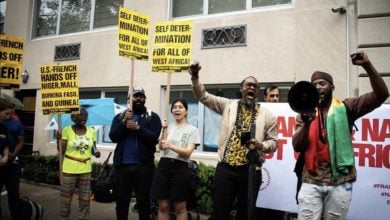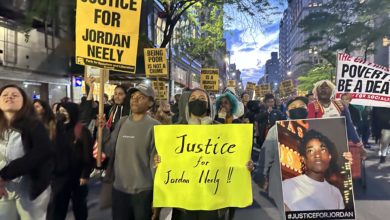Throughout U.S. history, Black people have called out the contradiction of being sent to kill and die in the U.S. military supposedly for “freedom” and “human rights,” while being denied them at home.
Legendary boxer Muhammed Ali famously explained his refusal to fight in the Vietnam war: “No Viet Cong ever called me n—–.”
Ali joined in a long tradition of Black anti-war sentiment, which found expression inside the military itself, as Black service members have repeatedly come to identify more with those targeted by U.S. imperialism than the racist politicians ordering them into war.
A long tradition of resistance
Gullah slaves fled South Carolina and Georgia to join Seminole communities in Spanish Florida. They fought for freedom in long guerrilla wars against the United States, before being forced along the Trail of Tears into Oklahoma. Seminoles of African descent later escaped Oklahoma Indian Territory in large numbers and went into Mexico. Establishing communities along the border with Texas territory, they were a forward front against U.S. forces after the Mexican American War, frequently fighting off Texas slave traders.
In 1899, after U.S. forces invaded and occupied the Philippines to capture it as a colony, Black soldier David Fagen defected to Emilio Aguinaldo’s guerrilla army along with several other Black service members. Fagen was so successful in combating the U.S. units that he rose to the rank of captain in the guerrilla army and became known as “General Fagen” among Filipino freedom fighters. His defection became international news, and U.S. commanders made his capture an obsession, putting a bounty on his head of $600. The military executed two other Black defectors to set an example for others.
In 1953, after the Korean War, Corporal Clarence Adams and two other Black soldiers were part of 21 U.S. troops who chose to live in China instead of participating in a prisoners-of-war swap. Adams in particular cited racism in the United States for his commitment to communist China. He broadcasted for Radio Hanoi during the Vietnam War from China, calling on other Black soldiers to throw down their weapons and go back to fight inequality at home. The Vietnamese liberation fighters frequently sent the same message to U.S. troops on the ground in flyers and billboards.
The 1944-45 ‘Battle of the Bulge’ was the first fully desegregated battle in U.S. history, which took place only out of necessity to defend against Hitler’s advance. Around 2,000 Black soldiers were enlisted for combat. After the war, however, many Black troops decided to stay in France where segregation did not exist. Other World War II veterans returned and became emboldened proponents of the Civil Rights Movement, including leaders like Medger Evers. A member of the White Citizens Council assassinated Evers in his driveway 18 years later.
Vietnam war and racism
The early part of the Vietnam War revealed that the U.S. government and military saw Black troops as cannon fodder. Blacks made up about 12 percent of the total U.S. civilian population but about 22 percent of casualties for the first several years of the conflict. These numbers only began to change when the disproportionate assignment of Black soldiers to firing teams and patrol became a big issue in the Civil Rights Movement, Black power movement and inside the military itself.
Black service members often led the way in acts of resistance and refusals to serve among soldiers. Because of these actions, coupled with the systemic racism of the U.S. military, the notorious Long Binh Jail, a military prison, was disproportionately Black. Over 700 incarcerated soldiers were crammed in a space made for about 400 people, with some put in shipping containers because of a lack of space.
In 1968, some white sailors responded to Martin Luther King Jr.’s assassination by donning Ku Klux Klan hoods, burning crosses and raising a Confederate flag. Dr. King had come out strongly against the war a year earlier, risking alienation from his powerful Democratic “friends.” In response to these racist incidents, their inhumane conditions, and assaults from white guards, a handful of Black prisoners at Long Binh Jail led an uprising that began on August 29, 1968 and lasted over a week, evolving into a full-blown revolt against the Army. One white prisoner was killed, and dozens were injured before the end of the rebellion, which destroyed the camp.
At home, Black soldiers played a key role in the dynamic and large GI resistance movement, which joined anti-war marches, refused to fight, confronted the officer corps and revolted in the barracks.
The National Black Anti-War Anti-Draft Union was formed in 1968, associated with the Black Panther Party and Student Nonviolent Coordinating Committee. At their first national conference they laid out a simple program to fight the draft and Vietnam War that called for, among other things, mass refusal to register with selective service, Black lawyers to defend war resisters, members of local draft boards and Black civil servants to disrupt the selective service process and Black service members to apply for Conscientious Objector status and organize against ROTC. In 1969, 15 members of NBAWADU broke into the Selective Service office and burned draft eligible files.
During Black History Month, few commemorations will contain these episodes of radical and revolutionary struggle. While fighting at home against the hypocrisy of the U.S. government, generations of Black service members have stood and fought against U.S. imperialism abroad.
In the present day, March Forward! is dedicated to the struggle against racism inside and outside of the military. It informs service members of their rights to refuse deployment to Afghanistan, and says to them: “We have more in common with the people of Iraq and Afghanistan than we do with the millionaires who tell us we must fight them.”






